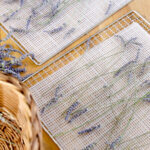Lovely Way to Dry Lavender Flowers after Harvest
How to dry lavender and preserve its fragrance all winter long. Get tips for air drying and using a dehydrator for beautiful results.
Equipment
- Scissors or garden shears
- Dehydrator
- Vase
Materials
- Fresh lavenders
Instructions
- Harvest lavender just before the flowers begin to open. I was cutting it way too close this year, and as a result, some of the flowers fell off the stalks after drying. The right timing is very important.
- Cut the lavender with plenty of stalks left.
Air Drying:
- Arrange lavender stalks in a vase and allow them to dry. That’s how easy it is!
- If you’re air drying a large amount, you can tie them together with string and hang them upside down to dry in a well-ventilated area.
Dehydrator:
- Cut the lavender heads off the stalls
- Arrange on dehydrator trays
- Set for 5 hours at 55 °C (130 °F)
Video
Notes
Tips for Drying Lavender
Air drying tips:
- Choose a dry, well-ventilated spot: For the best results, choose a dry, well-ventilated area to prevent mold and ensure even drying.
- Use a clean vase for air drying to avoid contamination. For larger amounts, tie lavender bundles with string, making sure they’re not packed too tightly to allow proper airflow.
- Keep an eye out for mold by checking your lavender regularly. If you spot any, lower the humidity in the drying area or improve ventilation.
Dehydrator tips:
- Arrange evenly: Spread lavender heads evenly on the dehydrator trays to ensure consistent drying and avoid overcrowding, which can hinder air circulation..
- Set the right temperature: Stick to the recommended 55 °C (130 °F) to avoid overheating, which can damage the fragrance and color of the lavender.
- Check for doneness: After 5 hours, check if the lavender is completely dry. It should be crumbly to the touch. If not, continue drying in 30-minute increments until ready.
Other tips:
- Harvesting: Cut lavender stems in the late morning when the essential oils are at their peak and haven't evaporated in the sun. Ensure the lavender is in full bloom for the best fragrance and color.
- Drying whole sprays: If you prefer to dry whole lavender bunches, tie the stems together and hang them upside down in a well-ventilated area. This method may take longer and is more susceptible to mold, so ensure good air circulation.
- Air circulation: For even drying, space out the lavender stems or bunches to allow air to circulate around them. You might use a drying rack or hang them in a dry, airy room.
- Turning: If laying lavender out flat on a tray or basket, turn the lavender every 12 hours to ensure even drying and prevent mold.
- Checking for dryness: Lavender is ready when the stems snap easily and the buds crumble between your fingers. Ensure all parts are completely dry before storing to avoid mold.
- Mixing: Once dried, you can mix lavender buds with other herbs like chamomile for unique tea blends or aromatic sachets.
- Hanging air dryers: For the best results, use hanging air dryers or racks that allow the lavender to dry evenly and maintain its fragrance.
Storage
Dried lavender can last for about 1 to 3 years if stored properly. Its fragrance will be strongest in the first year and may gradually fade over time. To maximize its shelf life, keep it in a vacuum-sealed bag or airtight container away from sunlight and moisture. Here's what you need to know about storing this fragrant gift from nature:
- Airtight containers: Store dried lavender in clean, airtight glass jars or containers. Ensure they are completely dry before sealing to prevent any moisture from causing mold.
- Cool, dark place: Keep the containers in a cool, dark cupboard or pantry away from direct sunlight and heat. This helps preserve the lavender’s color and fragrance.
- Vacuum-sealed bags: For long-term storage, use vacuum-sealed or food saver bags to remove excess air and maintain freshness. This method helps keep the lavender potent and aromatic.
- Silica gel packs: Place silica gel packs or moisture absorbers in the containers to control any residual moisture. This keeps the lavender dry and free from clumping.
- Freezer storage: If you live in a humid climate, consider storing dried lavender in the freezer in airtight containers or vacuum-sealed bags to preserve its quality for extended periods.
- Herb jars with tight lids: For smaller quantities, use herb jars with tight-fitting lids. These jars are designed to keep air and moisture out effectively.
- Labeling: Label each container with the date and type of lavender. This helps track freshness and ensures you use it within its optimal timeframe.
- Avoiding moisture: Keep lavender away from moisture sources like sinks or dishwashers. Excess moisture can lead to clumping and spoilage.
- Fridge storage: If storing in a fridge, ensure the container is tightly sealed to avoid moisture and odor absorption from other foods.
- Dark colored containers: Use dark-colored or opaque containers to protect lavender from light, which can degrade its color and scent over time.
